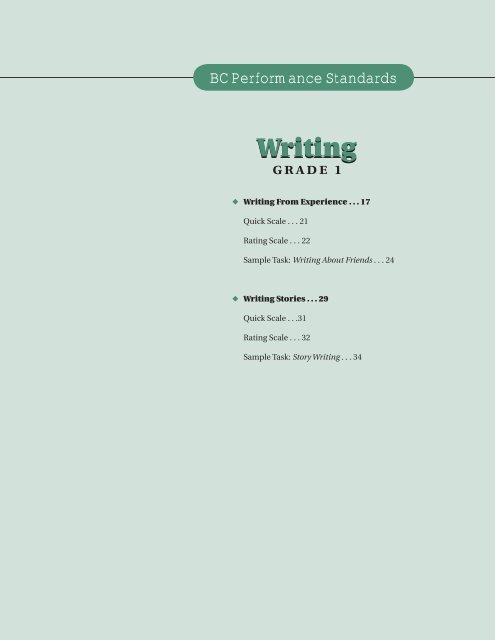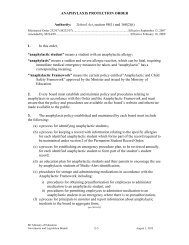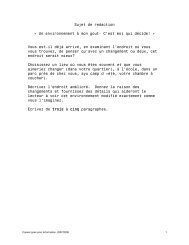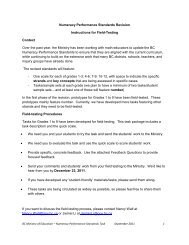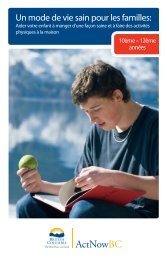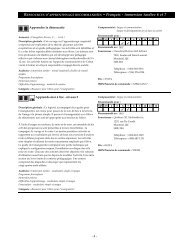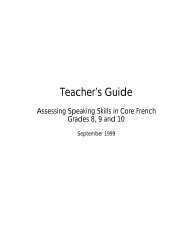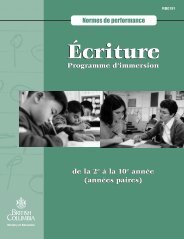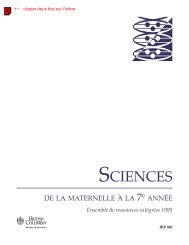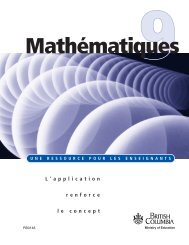BC Performance Standards - Writing - Grade 1
BC Performance Standards - Writing - Grade 1
BC Performance Standards - Writing - Grade 1
You also want an ePaper? Increase the reach of your titles
YUMPU automatically turns print PDFs into web optimized ePapers that Google loves.
<strong>BC</strong> <strong>Performance</strong> <strong>Standards</strong><br />
<strong>Writing</strong><br />
grade 1<br />
◆◆ <strong>Writing</strong> From Experience . . . 17<br />
Quick Scale . . . 21<br />
Rating Scale . . . 22<br />
Sample Task: <strong>Writing</strong> About Friends . . . 24<br />
◆◆ <strong>Writing</strong> Stories . . . 29<br />
Quick Scale . . .31<br />
Rating Scale . . . 32<br />
Sample Task: Story <strong>Writing</strong> . . . 34<br />
<strong>Grade</strong> 1 <strong>Writing</strong> From Experience 15
<strong>Writing</strong> From Experience<br />
<strong>Grade</strong> 1 students are asked to represent their thoughts, feelings,<br />
and opinions using both words and pictures. They frequently<br />
write:<br />
◆◆ labels and captions<br />
◆◆ journal entries<br />
◆◆ predictions about or responses to reading, listening, or viewing<br />
experiences<br />
◆◆ reflections on their learning<br />
◆◆ information about topics that interest them<br />
Early in <strong>Grade</strong> 1, children often convey most of their ideas through<br />
pictures. As they develop fluency in writing, an increasing amount of<br />
the meaning comes from written words.<br />
Most <strong>Grade</strong> 1 writing is first-draft writing—it is not revised, edited, or<br />
proofread. As students develop skills and confidence, however, they<br />
begin to check their work and make simple corrections to spelling,<br />
capitalization, and periods.<br />
Note:<br />
In later grades, the type of writing described in this section is classed as<br />
personal writing or writing to communicate ideas and information.<br />
In <strong>Grade</strong> 1, the general term writing from experience is used to describe<br />
any writing in which students record information they have acquired or<br />
their experiences, feelings, opinions, and observations.<br />
Key Qualities<br />
The following is a summary of the key qualities of each aspect of writing<br />
from experience in <strong>Grade</strong> 1. The Quick Scale and Rating Scale provide<br />
more details regarding specific criteria related to these key qualities.<br />
Meaning<br />
◆◆ comes from thoughts, feelings, opinions, memories, and<br />
reflections<br />
◆◆ may include information they have read, heard, or viewed<br />
<strong>Grade</strong> 1 <strong>Writing</strong> From Experience 17
Style<br />
◆◆ conversational—”spoken language written down”<br />
◆◆ may repeat patterns they have read or heard<br />
Form<br />
◆◆ follows forms modelled by the teacher<br />
◆◆ often includes pictures<br />
Conventions<br />
◆◆ includes both capitals and small letters<br />
◆◆ familiar words are increasingly spelled conventionally;<br />
uses phonics to spell new words<br />
◆◆ shows some sense of written sentences<br />
Prescribed Learning Outcomes<br />
The <strong>BC</strong> performance standards for <strong>Grade</strong> 1 writing from experience<br />
reflect the following prescribed learning outcomes from <strong>Grade</strong> 1 of the<br />
English Language Arts K to 7 Integrated Resource Package. Using the<br />
writing performance standards in a comprehensive way will provide<br />
teachers with many opportunities to assess these learning outcomes.<br />
Purposes (<strong>Writing</strong>)<br />
It is expected that students will:<br />
◆◆<br />
create straightforward personal writing and representations that<br />
express simple ideas, feelings, likes, and dislikes [C1]<br />
◆◆ create straightforward informational writing and representations,<br />
using prompts to elicit ideas and knowledge [C2]<br />
Strategies (<strong>Writing</strong>)<br />
[C4-6] Addressing these learning outcomes helps students in using<br />
strategies to develop their writing, but the <strong>Writing</strong> <strong>Performance</strong> <strong>Standards</strong><br />
describe the product not the processes used.<br />
Thinking (<strong>Writing</strong>)<br />
It is expected that students will:<br />
◆◆ use writing and representing to express personal responses and<br />
likes or dislikes about experiences or texts [C7]<br />
◆◆ use writing and representing to extend their thinking [C8]<br />
18<br />
bc PerFormance standards: writing
Features (<strong>Writing</strong>)<br />
It is expected that students will:<br />
◆◆ use some features and conventions of language to express meaning<br />
in their writing and representing [C10]<br />
<strong>Grade</strong> 1 <strong>Writing</strong> From Experience 19
20<br />
bc PerFormance standards: writing
Quick Scale: <strong>Grade</strong> 1 <strong>Writing</strong> From Experience<br />
The Quick Scale is a summary of the Rating Scale that follows. Both describe student achievement in March-April of the school year.<br />
Aspect Not Yet Within Expectations Meets Expectations Fully Meets Expectations Exceeds Expectations<br />
(Minimal Level)<br />
SNAPSHOT<br />
The writing may<br />
consist of a string of<br />
letters or be dictated<br />
for someone else to<br />
write down. The<br />
student needs a great<br />
deal of help.<br />
The writing is<br />
recognizable as<br />
conventional writing<br />
and conveys some<br />
ideas or information.<br />
The student often<br />
needs some help.<br />
The writing is<br />
readable and makes<br />
sense. The student is<br />
able to write<br />
independently with<br />
occasional help.<br />
The writing<br />
communicates ideas<br />
or information with<br />
some description and<br />
detail. The student is<br />
able to write<br />
independently.<br />
MEANING<br />
• ideas and<br />
information<br />
• details<br />
• may be able to<br />
“read” own writing,<br />
but meaning often<br />
changes each time<br />
• sentences or ideas<br />
may not be related<br />
• little development,<br />
few details<br />
• sentences or ideas<br />
are related<br />
• some detail<br />
• some individuality<br />
• develops a topic<br />
with supporting<br />
details<br />
STYLE<br />
• clarity and<br />
variety of<br />
language<br />
• description<br />
• simple words<br />
• when “reading” or<br />
dictating, may be<br />
one long sentence<br />
or a series of short,<br />
stilted sentences<br />
• conversational<br />
• repeats simple<br />
patterns, favourite<br />
words<br />
• conversational,<br />
some simple<br />
description<br />
• repeats simple<br />
patterns<br />
• some descriptive<br />
language<br />
• takes risks to use<br />
new words or<br />
patterns<br />
FORM<br />
• follows models<br />
or examples<br />
• sequence<br />
• usually a drawing<br />
with a string of<br />
letters or one or two<br />
dictated sentences<br />
• may be very brief<br />
• drawing may<br />
provide much of the<br />
information<br />
• follows form<br />
modelled by<br />
teacher<br />
• writing can stand<br />
alone<br />
• logically connected<br />
and sequenced<br />
• writing can stand<br />
alone<br />
CONVENTIONS<br />
• capitals and<br />
small letters<br />
• spelling<br />
• use of phonics<br />
• punctuation<br />
• spacing<br />
• legibility<br />
• strings of capital<br />
letters<br />
• may show correct<br />
initial consonant<br />
• not yet able to use<br />
phonics<br />
• no punctuation<br />
• may be copied or<br />
dictated to another<br />
person<br />
• mostly capital<br />
letters<br />
• some words spelled<br />
conventionally<br />
• many words spelled<br />
phonetically<br />
• may experiment<br />
with punctuation<br />
• parts are legible<br />
• both capitals and<br />
small letters<br />
• many familiar words<br />
spelled<br />
conventionally<br />
• new or unfamiliar<br />
words spelled<br />
phonetically<br />
• some punctuation<br />
• legible<br />
• both capitals and<br />
small letters<br />
• most familiar words<br />
spelled<br />
conventionally<br />
• phonics and word<br />
patterns used to<br />
solve spelling<br />
problems<br />
• generally written in<br />
sentences; uses<br />
punctuation<br />
• legible<br />
<strong>Grade</strong> 1 <strong>Writing</strong> From Experience 21<br />
GRADE 1 WRITING FROM EXPERIENCE 19
Rating Scale: <strong>Grade</strong> 1 <strong>Writing</strong> From Experience<br />
Student achievement in writing from experience tasks by March-April of <strong>Grade</strong> 1 can generally be described as shown in this scale.<br />
Aspect Not Yet Within Expectations Meets Expectations (Minimal Level)<br />
SNAPSHOT<br />
MEANING<br />
• ideas and<br />
information<br />
• details<br />
STYLE<br />
• clarity and<br />
variety of<br />
language<br />
• description<br />
FORM<br />
• follows models<br />
or examples<br />
• sequence<br />
CONVENTIONS<br />
• capitals and<br />
small letters<br />
• spelling<br />
• use of phonics<br />
• punctuation<br />
• spacing<br />
• legibility<br />
The writing may consist of a string of letters or be<br />
dictated for someone else to write down. The<br />
student needs a great deal of help.<br />
• may be able to “read” own writing, but meaning<br />
often changes each time<br />
• most of the meaning is in the drawing<br />
• simple words<br />
• when “reading” his or her writing, or dictating,<br />
may create one long, rambling sentence or a<br />
series of short, stilted sentences<br />
• may not resemble the form modelled by the<br />
teacher<br />
• usually a drawing labelled by a string of letters<br />
or one or two sentences that have been<br />
dictated to another person<br />
• strings of capital letters without spaces; single<br />
letters may represent words<br />
• may show correct initial consonant for an<br />
intended word<br />
• not yet be able to use sound-symbol<br />
relationships (phonics)<br />
• no punctuation<br />
• may be copied or dictated to another person<br />
The writing is recognizable as conventional writing<br />
and conveys some ideas or information. The student<br />
often needs some help.<br />
• sentences or ideas may not be related to<br />
each other<br />
• little development, few details<br />
• conversational language, simple words, little or no<br />
descriptive language<br />
• repeats simple patterns or favourite words, often<br />
those provided by the teacher; there is no flow to<br />
the sentences—they tend to be short and choppy<br />
or long and rambling<br />
• may overuse pronouns to the point where the<br />
reader is confused<br />
• attempts to follow the form modelled by the<br />
teacher<br />
• writing may be very brief, with much of the<br />
information provided by a drawing<br />
• tends to rely on capital letters; may include some<br />
small letters<br />
• some conventional spelling<br />
• many words spelled phonetically; may need<br />
frequent help in applying phonics<br />
• may experiment with punctuation; shows some<br />
sense of sentences when reading own writing<br />
aloud<br />
• parts are legible; other parts may be difficult to<br />
read<br />
* Student performance that falls within the wide range of expectations for <strong>Grade</strong> 1 by March-April generally matches the Level 2 descriptions in<br />
The rating scale may Evaluating require <strong>Writing</strong> adaptation Across Curriculum. when used for different purposes and tasks.<br />
22 20<br />
<strong>BC</strong> bc PERFORMANCE PerFormance standards: STANDARDS: writing<br />
WRITING
Fully Meets Expectations<br />
The writing is readable and makes sense. The student is<br />
able to write independently with occasional help.<br />
• sentences or ideas are related to each other<br />
• some detail<br />
Exceeds Expectations<br />
The writing communicates ideas or information with some<br />
description and detail. The student is able to write<br />
independently.<br />
• some sense of individuality or originality<br />
• develops a topic, often including supporting details that<br />
add “colour”<br />
• conversational language; may include some description<br />
• repeats simple sentences and patterns<br />
• may overuse pronouns, but the reader can usually tell to<br />
whom the pronouns refer<br />
• some words chosen for their effect; often includes some<br />
descriptive language<br />
• takes risks with new words or patterns<br />
• uses pronouns clearly<br />
• follows the form modelled by the teacher (e.g., list, web,<br />
paragraph)<br />
• writing makes sense standing alone; there may also be a<br />
detailed picture that adds information<br />
• ideas or events are logically connected and sequenced<br />
• writing makes sense standing alone; there may also be<br />
pictures to add interest or information<br />
• includes both capitals and small letters (may be<br />
inconsistent)<br />
• many familiar words are spelled conventionally<br />
• new or unfamiliar words are spelled phonetically;<br />
beginning to use phonics consistently<br />
• includes some punctuation (often applied inconsistently);<br />
shows some sense of written sentences<br />
• legible, although parts may be difficult to read; spaces<br />
between most words<br />
• includes both capitals and small letters<br />
• most familiar words are spelled conventionally<br />
• independently able to solve spelling problems, usually by<br />
applying phonics<br />
• generally written in sentences; may experiment with a<br />
variety of punctuation marks (e.g., exclamation, question,<br />
and quotation marks)<br />
• legible; there are spaces between the words<br />
<strong>Grade</strong> 1 <strong>Writing</strong> From Experience 23<br />
GRADE 1 WRITING FROM EXPERIENCE 21
Sample Task: <strong>Writing</strong> About Friends<br />
Context<br />
Students in this class regularly wrote and drew to record their<br />
experiences, feelings, and thoughts about specific topics. Their work<br />
was often connected to themes. This task was part of a class theme on<br />
“Friendship.”<br />
Process<br />
As a class, students were asked to think of as many words as they could<br />
that made personal connections to friends. The teacher recorded the<br />
words on a class web. Students then brainstormed a list of memorable<br />
experiences with friends, and the teacher recorded students’ responses<br />
on a separate chart. The class discussed why friends were important and<br />
how friends made them feel.<br />
The teacher provided the sentence frame A friend is … and asked<br />
students to write about their personal experiences with friends.<br />
Students were encouraged to write at least six sentences. They were also<br />
encouraged to consult the class web and chart for ideas and vocabulary.<br />
24<br />
bc PerFormance standards: writing
Not Yet Within Expectations<br />
Teacher’s Observations<br />
The student has recorded the teacher’s sentence stem and attempted to<br />
write strings of letters.<br />
◆◆ strings of letters<br />
◆◆ copied from the teacher<br />
◆◆ no punctuation<br />
Snapshot<br />
meaning<br />
style<br />
form<br />
conventions<br />
Not Yet Meets Fully Exceeds<br />
Transcript<br />
A friend is<br />
Afriendi s indet oHo<br />
Afren i<br />
Afrietep<br />
Afet<br />
<strong>Grade</strong> 1 <strong>Writing</strong> From Experience 25
Meets Expectations (Minimal Level)<br />
Teacher’s Observations<br />
The writing begins with a sense of individuality, but becomes<br />
increasingly difficult to read because of problems with the conventions<br />
of writing.<br />
◆◆ some sense of individuality<br />
◆◆ conversational language<br />
◆◆ some conventional spelling<br />
◆◆ many words spelled phonetically<br />
◆◆ experiments with punctuation<br />
◆◆ parts are difficult to read<br />
Snapshot<br />
meaning<br />
style<br />
form<br />
conventions<br />
Not Yet Meets Fully Exceeds<br />
Transcript<br />
this is a Pome Ofu friends. friends are nice to es uthr. and friends cheer up es.<br />
aurfriend Be nice to ese. friend are fun. friend are the Bist. a friend cun help.<br />
26<br />
bc PerFormance standards: writing
Fully Meets Expectations<br />
Teacher’s Observations<br />
The student makes personal connections to friends. The writing is<br />
readable and makes sense.<br />
◆◆ sentences and ideas are related to each other<br />
◆◆ conversational language<br />
◆◆ includes both capitals and small letters<br />
◆◆ many familiar words are spelled conventionally<br />
◆◆ legible; there are spaces between the words<br />
Snapshot<br />
meaning<br />
style<br />
form<br />
conventions<br />
Not Yet Meets Fully Exceeds<br />
Transcript<br />
A friend is special To me I Licit wen my friend is nos to me. A Friend is nice To<br />
me. A friend Play’s wiTh me. A fricnd Toss secrets aBouT Me. I Like my Friend my<br />
Friend is Angie I Like Angie nye is nos To me. my oThre Friend is Tara nye is verey<br />
nos. I Like mrs Bain.<br />
<strong>Grade</strong> 1 <strong>Writing</strong> From Experience 27
Exceeds Expectations<br />
Teacher’s Observations<br />
The writing offers ideas and feelings with some elaboration and detail,<br />
and it flows smoothly.<br />
◆◆ some sense of originality<br />
◆◆ supporting details add colour<br />
◆◆ takes risks with new words and patterns<br />
◆◆ ideas are logically connected<br />
◆◆ most familiar words are spelled conventionally<br />
◆◆ written in sentences<br />
Snapshot<br />
meaning<br />
style<br />
form<br />
conventions<br />
Not Yet Meets Fully Exceeds<br />
Transcript<br />
A freind is purie and true and helpfall… A freind sheris felings and we sheris<br />
aures to. A friend is special in evry way. We fiedl sad wen they are sad. A friend is<br />
ter wen you need them and you aue ter wen they need you to. “I Like freinds a<br />
lot do you?” A freind is so nice you can even see it for your seillf. A freind is important<br />
in evry way thet you can think of. A freind is the one tet plays with you wen you<br />
need them. Mote popeyl have a feind of thre ona and you poblye have one to.<br />
28<br />
bc PerFormance standards: writing
<strong>Writing</strong> Stories<br />
<strong>Grade</strong> 1 students often enjoy writing stories. Their stories<br />
are usually modelled on those they have read or heard.<br />
They recount personal stories; retell stories they have read,<br />
heard, or viewed; write new endings or new adventures for familiar<br />
stories; or create imagined stories. They often need the support of a<br />
frame or outline as they compose and write.<br />
Early in <strong>Grade</strong> 1, children often convey most of the meaning in their<br />
stories through pictures. As they develop fluency in writing, an increasing<br />
amount of the meaning comes from their written words.<br />
Like most writers, <strong>Grade</strong> 1 students enjoy sharing their work and are<br />
increasingly interested in the reaction of their classmates and families, as<br />
well as the teacher. They begin to experiment with “story language” and<br />
with the power of descriptive words. With support, they begin to identify<br />
strengths in their stories and find places where they might add ideas to<br />
make the story easier to understand or more interesting.<br />
<strong>Grade</strong> 1 students may reread their work and make simple corrections.<br />
However, they are not usually expected to make extensive revisions or<br />
produce “good” copies.<br />
Key Qualities<br />
The following is a summary of the key qualities of each aspect of writing<br />
stories in <strong>Grade</strong> 1. The Quick Scale and Rating Scale provide more details<br />
regarding specific criteria related to these key qualities.<br />
Meaning<br />
◆◆ comes from imagination, memories, and selections they have read,<br />
heard, or viewed<br />
Style<br />
◆◆ conversational—“spoken language written down”<br />
◆◆ may experiment with description and “story language”<br />
<strong>Grade</strong> 1 <strong>Writing</strong> From Experience 29
Form<br />
◆◆ follows “beginning-middle-end” structure<br />
◆◆ often includes pictures<br />
Conventions<br />
◆◆ includes both capitals and small letters<br />
◆◆ familiar words increasingly spelled conventionally; uses phonics to<br />
spell new words<br />
◆◆ shows some sense of written sentences<br />
Prescribed Learning Outcomes<br />
The <strong>BC</strong> performance standards for <strong>Grade</strong> 1 story writing reflect the<br />
following prescribed learning outcomes from <strong>Grade</strong> 1 of the<br />
English Language Arts K to 7 Integrated Resource Package. Using the<br />
writing performance standards in a comprehensive way will provide<br />
teachers with many opportunities to assess these learning outcomes.<br />
Purposes (<strong>Writing</strong>)<br />
It is expected that students will:<br />
◆◆<br />
create imaginative writing and representations, often modelled on<br />
those they have read, heard, or viewed [C3]<br />
Strategies (<strong>Writing</strong>)<br />
[C4-6] Addressing these learning outcomes helps students in using<br />
strategies to develop their writing, but the <strong>Writing</strong> <strong>Performance</strong> <strong>Standards</strong><br />
describe the product not the processes used.<br />
Thinking (<strong>Writing</strong>)<br />
It is expected that students will:<br />
◆◆ use writing and representing to extend their thinking [C8]<br />
Features (<strong>Writing</strong>)<br />
It is expected that students will:<br />
◆◆ use some features and conventions of language to express meaning<br />
in their writing and representing [C10]<br />
30<br />
bc PerFormance standards: writing
Quick Scale: <strong>Grade</strong> 1 <strong>Writing</strong> Stories<br />
The Quick Scale is a summary of the Rating Scale that follows. Both describe student achievement in March-April of the school year.<br />
Aspect Not Yet Within Expectations Meets Expectations Fully Meets Expectations Exceeds Expectations<br />
(Minimal Level)<br />
SNAPSHOT<br />
The story may consist of<br />
a string of letters or be<br />
dictated for someone<br />
else to write down. The<br />
student needs a great<br />
deal of help.<br />
The story is recognizable<br />
as conventional writing<br />
and has some elements<br />
of a story. The student<br />
often needs some help.<br />
The story is readable<br />
and makes sense. The<br />
student is able to write<br />
independently with<br />
occasional help.<br />
The story has some<br />
description and detail.<br />
The student is able to<br />
write independently.<br />
MEANING<br />
• ideas and<br />
information<br />
• details<br />
• may be able to “read”<br />
own writing, but<br />
meaning often<br />
changes each time<br />
• often retells another<br />
story<br />
• recognizable story<br />
situation<br />
• little development,<br />
few details<br />
• some individuality<br />
• begins with<br />
characters and<br />
situation<br />
• has a problem and<br />
solution; few details<br />
• some individuality<br />
• begins with<br />
characters and<br />
situation<br />
• has a problem and<br />
related solution;<br />
details add “colour”<br />
STYLE<br />
• clarity and<br />
variety of<br />
language<br />
• description<br />
• simple words<br />
• when “reading” or<br />
dictating, may be one<br />
long, rambling<br />
sentence or a series of<br />
short, stilted sentences<br />
• conversational<br />
• repeats simple<br />
patterns, favourite<br />
words<br />
• mostly conversational;<br />
may include some<br />
“story language”<br />
• repeats simple<br />
patterns; some simple<br />
description<br />
• takes risks,<br />
experiments; shows<br />
awareness of the<br />
effects of interesting<br />
language<br />
• often has dialogue,<br />
description<br />
FORM<br />
• beginning,<br />
middle, end<br />
• sequence<br />
• usually a drawing with<br />
a string of letters or<br />
one or two dictated<br />
sentences<br />
• may be very brief<br />
• string of loosely<br />
related events—<br />
mostly “middle”<br />
• uses and to connect<br />
ideas<br />
• drawing may tell much<br />
of the story<br />
• includes beginning,<br />
middle, and end<br />
• most events are in<br />
logical sequence<br />
• repeats the same<br />
connecting words<br />
• writing can stand<br />
alone<br />
• includes beginning,<br />
middle, and end<br />
• events are in logical<br />
sequence<br />
• uses a variety of<br />
connecting words<br />
• writing can stand<br />
alone<br />
CONVENTIONS<br />
• capitals and<br />
small letters<br />
• spelling<br />
• use of phonics<br />
• punctuation<br />
• spacing<br />
• legibility<br />
• strings of capital<br />
letters<br />
• may use correct initial<br />
consonant<br />
• not yet able to use<br />
phonics<br />
• no punctuation<br />
• may be copied or<br />
dictated to another<br />
person<br />
• mostly capital letters<br />
• some words spelled<br />
conventionally<br />
• many words spelled<br />
phonetically<br />
• may experiment with<br />
punctuation<br />
• parts are legible<br />
• both capitals and<br />
small letters<br />
• spells many familiar<br />
words correctly<br />
• uses phonics to spell<br />
new words<br />
• some punctuation<br />
• legible<br />
• uses both capitals<br />
and small letters<br />
• most familiar words<br />
spelled<br />
conventionally<br />
• phonics and word<br />
patterns used to<br />
solve spelling<br />
problems<br />
• generally written in<br />
sentences; uses<br />
punctuation<br />
• legible<br />
<strong>Grade</strong> 1 <strong>Writing</strong> From Experience 31<br />
GRADE 1 WRITING STORIES 31
Rating Scale: <strong>Grade</strong> 1 <strong>Writing</strong> Stories<br />
Student achievement in story-writing tasks in <strong>Grade</strong> 1 in March-April can generally be described as shown in this scale.<br />
Aspect Not Yet Within Expectations Meets Expectations (Minimal Level)<br />
SNAPSHOT<br />
MEANING<br />
• ideas and<br />
information<br />
• details<br />
The story may consist of a string of letters or be<br />
dictated to someone else to write down. The<br />
student needs a great deal of help.<br />
• may be able to “read” own writing, but meaning<br />
often changes with subsequent readings<br />
• drawing often provides most of the meaning<br />
The story is recognizable as conventional writing<br />
and has some elements of a story. The student often<br />
needs some help.<br />
• often retells another story<br />
• recognizable story situation<br />
• sometimes there is no story problem<br />
• little development, few details<br />
• may seem unaware of audience<br />
STYLE<br />
• clarity and<br />
variety of<br />
language<br />
• description<br />
FORM<br />
• beginning,<br />
middle, end<br />
• sequence<br />
CONVENTIONS<br />
• capital and small<br />
letters<br />
• spelling<br />
• use of phonics<br />
• punctuation<br />
• spacing<br />
• legibility<br />
• simple words<br />
• when “reading” his or her writing or dictating,<br />
may create one long, rambling sentence or a<br />
series of short, stilted sentences<br />
• often a drawing, labelled by a string of letters or<br />
with one or two sentences that have been<br />
dictated to another person<br />
• may not resemble a story<br />
• writes in strings of capital letters without<br />
spaces; single letters may represent words<br />
• may show correct initial consonant for an<br />
intended word<br />
• not yet able to use sound-symbol relationships<br />
(phonics)<br />
• no punctuation<br />
• may be copied or dictated to another person<br />
• conversational language; simple words; may<br />
repeat a favourite descriptive word or phrase<br />
• repeats simple sentences and patterns (e.g., and<br />
then); there is no flow to the sentences—they tend<br />
to be short and choppy or long and rambling<br />
• may overuse pronouns to the point where the<br />
reader is confused<br />
• tends to be a string of loosely related events—<br />
mostly “middle”—without a real ending<br />
• often very brief; much of the story may be told<br />
in a drawing<br />
• may overuse and to connect ideas<br />
• tends to use capital letters; may include some<br />
small letters<br />
• some conventional spelling<br />
• many words spelled phonetically; may need<br />
frequent help in applying phonics<br />
• may experiment with punctuation; shows<br />
some sense of sentences when reading own<br />
writing aloud<br />
• parts are legible; other parts may be difficult<br />
to read<br />
* Student performance that falls within the wide range of expectations for <strong>Grade</strong> 1 by March-April generally matches the Level 2/3 descriptions in<br />
The rating scale may Evaluating require <strong>Writing</strong> adaptation Across Curriculum. when used for different purposes and tasks.<br />
32<br />
<strong>BC</strong> bc PERFORMANCE PerFormance standards: STANDARDS: writing<br />
WRITING
Fully Meets Expectations<br />
The story is readable and makes sense. The student is able<br />
to write independently with occasional help.<br />
Exceeds Expectations<br />
The story has some description and detail. The student is<br />
able to write independently.<br />
• some evidence of individuality<br />
• identifies characters and situation at the beginning of<br />
the story<br />
• includes a problem and solution (solution may be abrupt)<br />
• few supporting details<br />
• may not consider audience<br />
• primarily conversational language; may include some<br />
description and “story language” (e.g., once upon a time)<br />
• repeats simple sentences and patterns<br />
• may overuse pronouns, but the reader can usually tell to<br />
whom the pronouns refer<br />
• some sense of individuality or originality<br />
• identifies characters and situation at the beginning of<br />
the story<br />
• story usually includes a logical problem and a related<br />
solution<br />
• includes supporting details that add “colour”<br />
• shows a sense of audience<br />
• moving toward literary structures; takes risks; shows<br />
awareness of the effects of interesting language<br />
• may use a variety of sentences; often includes dialogue<br />
• uses pronouns clearly<br />
• includes beginning, middle, and end; the written story<br />
makes sense standing alone<br />
• most events are logically connected; may “wander” into a<br />
new problem<br />
• repeats the same connecting words (e.g., and then)<br />
• includes both capitals and small letters (may be<br />
inconsistent)<br />
• many familiar words are spelled conventionally<br />
• new or unfamiliar words are often spelled phonetically;<br />
beginning to use phonics consistently<br />
• includes some punctuation (often applied inconsistently);<br />
shows some sense of written sentences<br />
• legible, although parts may be difficult to read; spaces<br />
between most words<br />
• includes beginning, middle, and end; the written story<br />
makes sense standing alone<br />
• events are logically connected and sequenced<br />
• uses a variety of connecting words (e.g., and, so, then, but,<br />
when, after)<br />
• includes both capitals and small letters<br />
• most familiar words are spelled conventionally<br />
• independently able to solve spelling problems, usually by<br />
applying phonics<br />
• generally written in sentences; may experiment with a<br />
variety of punctuation marks (e.g., exclamation, question,<br />
and quotation marks)<br />
• legible; there are spaces between the words<br />
<strong>Grade</strong> 1 <strong>Writing</strong> From Experience 33<br />
GRADE 1 WRITING STORIES 33
Sample Task: Story <strong>Writing</strong><br />
Context<br />
Throughout the year, students in this classroom regularly listened to<br />
stories and discussed the events and characters in them. They practised<br />
identifying characters, setting, problems, and solutions. They also<br />
created banks of words and phrases to describe characters; recorded the<br />
beginning, middle, and end; and retold and dramatized stories.<br />
Process<br />
Prior to independent writing, students worked on retelling and writing<br />
familiar stories. As a class, they brainstormed familiar stories they had<br />
read or heard. In pairs, students chose a familiar story and identified the<br />
characters, setting, problems, and solutions. They practised rewriting<br />
familiar stories to help develop style and form (e.g., clarity of language<br />
and sequence).<br />
Students were then asked to write their own stories. The class<br />
brainstormed a bank of topics, and the teacher recorded their ideas<br />
on a class chart. The class discussed the variety of ways a story could<br />
be introduced, who could be in the story, where it could happen, what<br />
problem might occur, and how the problem might be solved. They also<br />
discussed the use of conventions in story writing, such as the use of<br />
capitals and periods. The teacher encouraged students to record their<br />
ideas in a logical sequence, follow a beginning-middle-end structure, and<br />
include some punctuation.<br />
As students wrote their stories, the teacher consulted with them and<br />
provided assistance as needed.<br />
34<br />
bc PerFormance standards: writing
Not Yet Within Expectations<br />
Teacher’s Observations<br />
The story consists of strings of letters. The student had difficulty reading<br />
the story aloud and changed the meaning of parts of it several times.<br />
◆◆ does not resemble a story<br />
◆◆ uses the correct initial consonant for intended words in places<br />
(not consistent)<br />
◆◆ no punctuation<br />
Snapshot<br />
meaning<br />
style<br />
form<br />
conventions<br />
Not Yet Meets Fully Exceeds<br />
Transcript<br />
Mn A faND F, is f a ND F E is g the Rafooh Fors we pIYe inTheBa r oa Fks<br />
<strong>Grade</strong> 1 <strong>Writing</strong> From Experience 35
Meets Expectations (Minimal Level)<br />
Teacher’s Observations<br />
The story consists of a series of loosely connected ideas about an orange<br />
cat. It has few elements of a story and little development.<br />
◆◆ there is no story problem<br />
◆◆ little development, few details<br />
◆◆ conversational language, simple words<br />
◆◆ most familiar words are spelled conventionally<br />
◆◆ legible; there are spaces between the words<br />
Snapshot<br />
meaning<br />
style<br />
form<br />
conventions<br />
Not Yet Meets Fully Exceeds<br />
Transcript<br />
Once a upon a time we had a orang cat my dad likes orang cats but it was not are<br />
cat it plays in the tree sum times it plays on the fens<br />
36<br />
bc PerFormance standards: writing
Fully Meets Expectations<br />
Teacher’s Observations<br />
The story is readable and makes sense. The student is beginning to take<br />
risks with language.<br />
◆◆ some evidence of individuality<br />
◆◆ includes some description and “story language”<br />
◆◆ most events are logically connected<br />
◆◆ new or unfamiliar words are spelled phonetically<br />
◆◆ legible; there are spaces between the words<br />
Snapshot<br />
meaning<br />
style<br />
form<br />
conventions<br />
Not Yet Meets Fully Exceeds<br />
Transcript<br />
Oncs upon a time There was a little gerl she was going to pik some floers foere<br />
her mom she fawd some floers but when she got there she saw The Ester bunny<br />
They pikt a lot uf floere They hopt all The way home when They got home her<br />
Mom was amasde that she brot The Ester bunny home<br />
<strong>Grade</strong> 1 <strong>Writing</strong> From Experience 37
Exceeds Expectations<br />
Teacher’s Observations<br />
The student presents a complete story with details and description about<br />
a scary, but not mean, sea serpent.<br />
◆◆ some sense of originality<br />
◆◆ story includes a logical problem and a related solution<br />
◆◆ includes supporting details that add “colour”<br />
◆◆ shows a sense of audience<br />
◆◆ takes risks with interesting language<br />
◆◆ generally written in sentences; experiments with a variety<br />
of punctuation<br />
Snapshot<br />
meaning<br />
style<br />
form<br />
conventions<br />
Not Yet Meets Fully Exceeds<br />
Transcript<br />
This student included many small drawings at the end of sentences to<br />
illustrate key images in the story.<br />
The sea srpnt<br />
Once upon a time there was a sea srpnt. Eeven thow he was sceree he was not<br />
meen. Oue day he went too the Harbru. The srpnt wattde for a ship to leev. A ship<br />
was leeving. The ship was the Blue Nows. She was salinge for a now Ilide. But a<br />
ould man said “yod be shot bie Pirates”. The srpnt didn’t wot that too hapun sow<br />
the srpnt followd the ship. A pirate ship came in site. The pirate shot and blow the<br />
sayols to shreds. The pirates worrr jost a bawt too blow them to shreds. But the<br />
srpnt went undr and went up … and crakt the pirate ship like a nut shel. The Blue<br />
Nowse coodnot go withowt sayols. The srpnt thot then grab the angkr with his<br />
jow. The captin said “hees bring us sath sowe lets setol dawn and injy the ride”.<br />
The srpnt brot them rite too land<br />
38<br />
bc PerFormance standards: writing


